photo by Bob Strano taken at the Walter Reade Theatre Lincoln Film Center Sept. 2009 at the
world premiere of Gary's live score accompanying Todd Browning's "The Unholy Three" (1925)
-
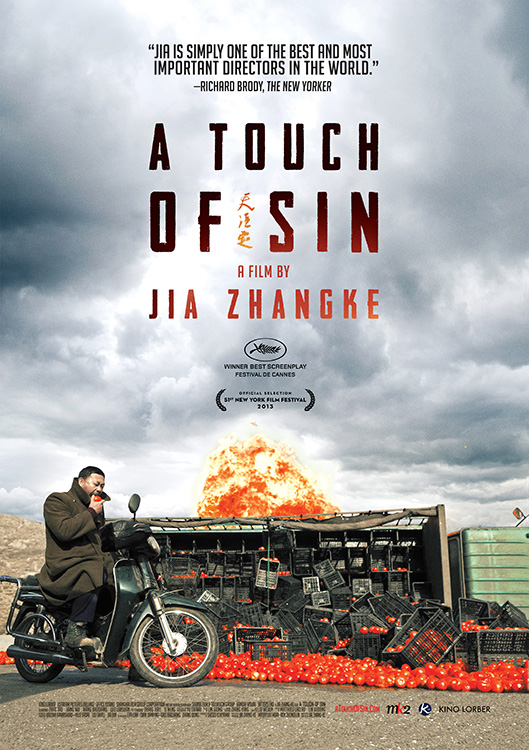

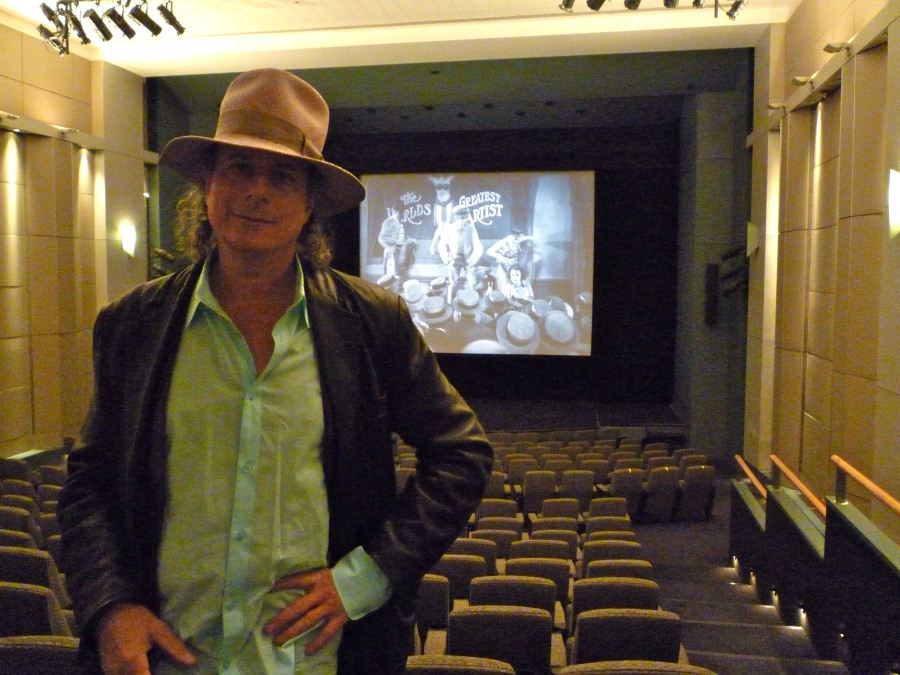
 "A TOUCH OF SIN" (2013, d. 賈樟柯 Jia Zhangke)
"A TOUCH OF SIN" (2013, d. 賈樟柯 Jia Zhangke)
I have had an ongoing love affair with Chinese culture (especially music, cinema and food) going back to my two years spent living in Taipei after graduating college in the mid-70's. In the 90's I began arranging and performing Chinese pop classics from Shanghai's 1930's Golden Age, and have worked extensively in this genre to this day, including performing several times in Shanghai. To me, the greatest living Chinese director (and one of the best contemporary directors going) is the excellent and controversial Jia Zhangke, and this is his finest and most provocative film—a lyrical and hypnotic tour de force which weaves together 4 shockingly violent stories torn from the pages of contemporary Chinese newspapers, with episodes that take place across the length and breadth of mainland China in big cities and rural hamlets. In telling these tales—so-called wuxia stories, a Chinese term akin to samurai stories concerning heroes who rise up from the lower classes seeking vengeance on corrupt people in power—the film touches on many modern Chinese problems which goes to the heart of the enormous changes taking place on the mainland, with rapid industrialization and endemic corruption. The film is beautifully photographed but its disquieting and ultimately tragic vision of a rising society simultaneously in moral free-fall proved too strong for mainland censors, who ultimately refused to distribute it in China. Thankfully the film subsequently received a rapturous reception abroad, winning a Palme D'Or at the 2013 Cannes Film Festival. The title in Chinese, "Tian Zhuding", literally translates as "heavenly fate", or "fated doom", while its English title is a reference to King Hu's 1971 action epic "A Touch of Zen", one of the most influential wuxia films.
-
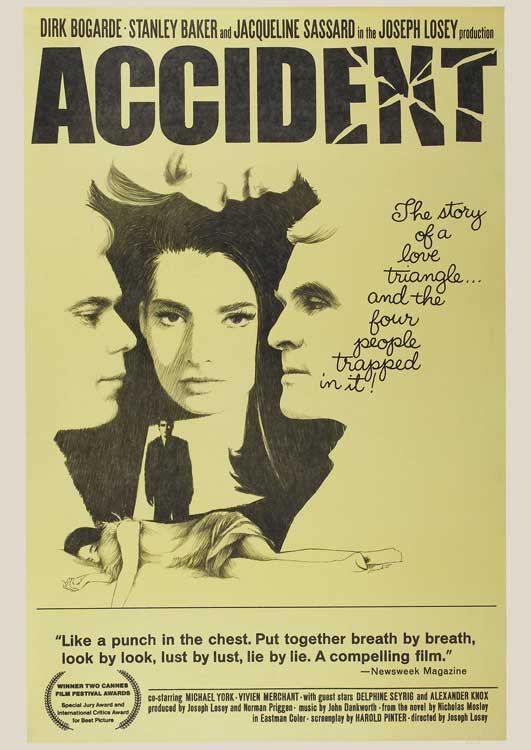
 "ACCIDENT" (1967, d. Joseph Losey)
"ACCIDENT" (1967, d. Joseph Losey)
The great American ex-pat director Joseph Losey—my particular all-time favorite cineaste — was a successful theater director in New York before establishing a beachhead in Hollywood where he made some memorable films (including the noir-ish "The Criminal", which I will get to)—but he was eventually hounded out of the US during the McCarthy Era anti-communist witch hunt of the early 50's. Blacklisted and unable to work in his own country, Losey successfully relocated to Britain, where he quickly established himself and where his career really took off, and he worked steadily there and on the continent for many years. His high-water mark to me was when he hooked up with the acerbic UK playwright and scenarist Harold Pinter for three astonishing films: "The Servant", "The Go-Between", and this one. Based on the novel by Nicholas Moseley and sporting a superb cast including Dirk Bogarde, Stanley Baker, Michael York, Vivien Merchant, and Jacqueline Sassard, with a memorable score by jazz legend John Dankworth, "Accident" has the impact of a hand-grenade detonating in your face at a garden party. Set in the groves of English academe, the film details the adulterous rivalry of Oxford professor Bogarde and fellow academic Baker over the affections of a young Austrian student princess played by newcomer Sassard—with devastating consequences for all. All of Losey's dazzling stylistic tropes are in full effect here: lots of reflections in mirrors and polished surfaces, abrupt cuts to seemingly random scenes in the middle of a sentence, multiple flashbacks and flash forwards that shuffle time and space with aplomb. Pinter's script conveys the same pitch of menace and dislocated absurdity that will be familiar to folks who have seen "The Servant", or one of his own plays such as "The Caretaker". Provocative cinema at its mordant best.
-
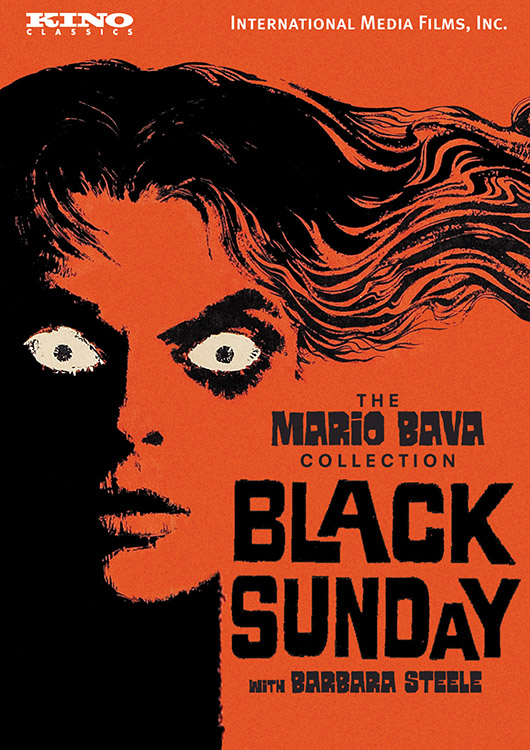
 "BLACK SUNDAY" (1960, d. Mario Bava)
"BLACK SUNDAY" (1960, d. Mario Bava)
I am a huge fan of classic horror, fantasy and science fiction films since I was a little boy and discovered the magazine Famous Monsters of Filmland at my local drugstore in 1959, and I have composed and performed numerous live scores for many of my favorite horror films over the years. This 1960 black and white shocker by giallo master Mario Bava, released in Italy under the title "La Maschera del Demonio", is my #1 all-time favorite horror film, with a sensationally sensual performance by female horror icon British actress Barbara Steele. The film had an enormous effect on me which has lingered to this day. Based on the short story "The Vij" by Russian author Nikolai Gogol, Bava pulled all the stops out here to create a film dripping in an atmosphere of decay suffused with an overwhelming feeling of dread. The film concerns the discovery and subsequent reanimation of Steele's Princess Asa Vajda, a vampiric sorceress burned at the stake in 17th century Moldava, and now interred in an old crypt in the crumbling ruins of a noble family's castle. Asa returns to life in all her wicked glory 200 years later through the clumsy actions of a professor traveling in the region, who discovers her tomb. Standing over her wormy remains reposing in her sarcophagus, he accidentally pricks his finger, and a drop of his blood spills onto her corpse—thus bringing her back to life to walk the earth again, hell-bent for vengeance against the descendants of the noble family who first tortured and immolated her two centuries previously. The conflation in this film of a suffocating fogbound mise-en-scene, and the awesome awakening of Steele in the ruined crypt, writhing and quivering on her slab with blood-lust in her eyes before indoctrinating the hapless professor who stumbled upon her into the joys of Eternal Life with the Kiss of the Vampire, is just about the most erotic sequence I've ever witnessed in cinema, and certainly worth the price of admission alone. A great, great film.
-
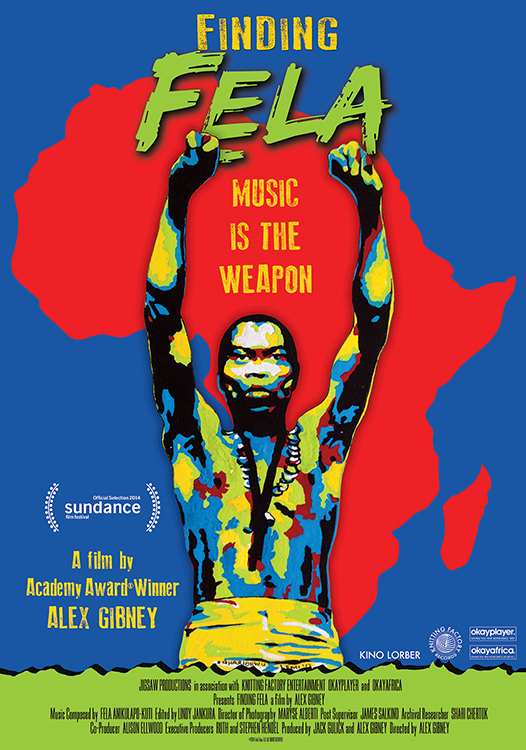
 "FINDING FELA" (2014, d. Alex Gibney)
"FINDING FELA" (2014, d. Alex Gibney)
I was raised on classic old school Broadway musicals ("My Fair Lady", "The Pajama Game", "The Music Man") thanks to my parents who adored such fare in the late 50's and early 60's, and I saw many productions on the Great White Way over the years. But the greatest musical I've ever seen live though, bar none, has to be "Fela!", based on the outrageous life of charismatic African musical and political revolutionary Fela Anikulapo Kuti, whose fierce outbursts against the corrupt Nigerian government and systemic oppression of common people by multi-national corporations around the world were set indelibly to ass-shaking funky percussive music on a series of incendiary Afro-beat recordings that were played on dance floors everywhere from Lagos to London. I loved Fela's records and bought them all as they came out (he was very prolific), and was fortunate to see him play live at Madison Square Garden in the mid 80's after they let him out of a Nigerian prison where he'd been incarcerated for several years on charges of anti-government activities. In 2008 the late political and musical icon's colorful life was retold by award-winning choreographer/director Bill T. Jones in a spectacular Tony Award-winning musical which my wife and I saw 5 times—and which traveled successfully all over the world (including a run in Lagos, Fela's ancestral home where he developed Afro-Beat over the years at his club and living space The Shrine, which he later declared the sovereign Republic of Kalakuta). This great documentary directed by Academy-Award winning director Alex Gibney tells both Fela's actual story through many rare historic clips, and the development of the "Fela!" musical's parallel story, which includes interviews with many of the participants, rehearsal footage in the run-up to the shows' premiere, and sizzling live performance footage direct from Broadway.
-
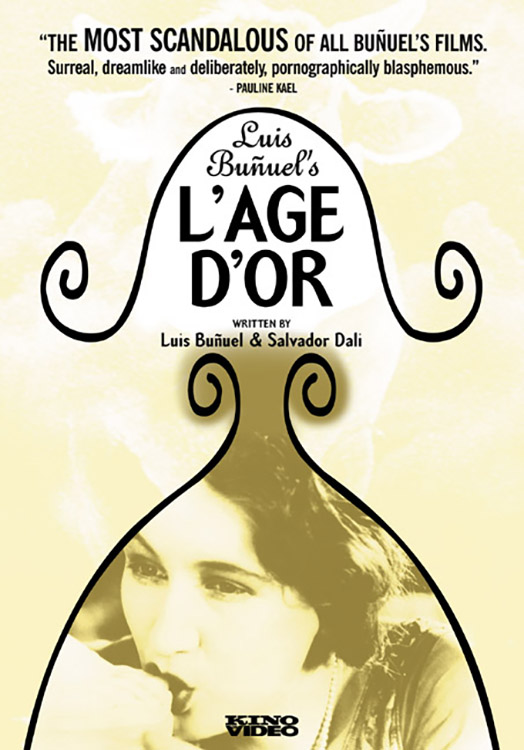
 "L'AGE D'OR" (1930, d. by Luis Buñuell and written by Bunuel with Salvador Dalí)
"L'AGE D'OR" (1930, d. by Luis Buñuell and written by Bunuel with Salvador Dalí)
"Bunuel and Dali are back—and Paris has got ‘em!" The surrealist tag-team of Luis Bunuel and Salvador Dali—the "gruesome twosome" who spectacularly epater'ed le bourgeois with their very first collaboration, the silent short "Un Chien Andalou" in 1929, which shocked and scandalized French audiences upon its premiere in Paris and continues to provoke new generations of film scholars worldwide—return here with a less frenetic, more geniale and discursive, almost feature-length film (63 minutes), a satiric comedy which lovingly comments on, illuminates and dissects all the now familiar tropes that obsessed the pair, and especially Bunuel throughout his lengthy career: Money, Power, the Insanity of Modern Life, the Hypocrisy of the Catholic Church, Erotic Madness (l'Amour Fou), the primacy of the hallucinatory Dream State, the Absurdity of Existence, and so forth. Featuring a pre-exisitng score that leans heavily on the swooning "Liebestod" from Wagner's "Tristan and Isolde", and a cameo from fellow surrealist Max Ernst, the film ends with a reference to the Marquis De Sade's notorious screed "The 120 Days of Sodom", with a bearded Count (here made-up to resemble a debauched wastrel version of Jesus Christ) appearing outside the gates of a Castle to coax a lone female orgiast back inside. After an off-screen scream is heard, the Count re-emerges energized and now clean-shaven. Deliriously naughty fun, and a certified film classic.
-
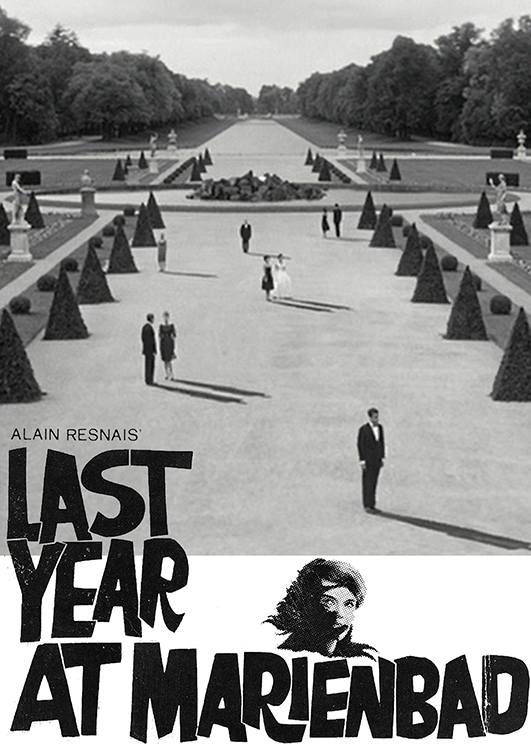
 "LAST YEAR AT MARIENBAD" (1961, d. Alain Resnais)
"LAST YEAR AT MARIENBAD" (1961, d. Alain Resnais)
This hypnotic film hs been called one of the greatest and also one of the worst films of all times, for its overwhelming emphasis on Style over Content—there is no simple explanation of "what it all means" proffered at the end, or anything like a linear narrative plot. Regarding this film I am firmly in the first camp, as Resnais in collaboration with French New Wave author / scenarist Alain Robbe-Grillet fashioned here the most perfect enigma, a formally elegant jewel containing all the multi-faceted logic of a dream—and in that, it can comfortably be placed in the Surrealist camp, except to say it bears very little relation to what a Surrealist director like Bunuel gets up to, although formally Resnais and Bunuel share many of the same devices (disjunctive narrative and abrupt shifts of time, for instance). The film is beautifully photographed in perfect black and white on the garlanded grounds and lush interior corridors, patios, ballrooms and chambers of an elegant old European palace now a hotel spa, which the very mobile camera of Sasha Vierny prowls and explores intimately, while a sepulchral narrative voice alludes to a sketchy relationship (with intimations of possible off-screen seduction, rape and murder) between 3 characters known only in the published screenplay as A, X, and M. The great French actress Delphine Seyrig stars as the ice-queen object of amorous pursuit, and her brother Francis provides the creepy organ music which comprises the score. In its relentlessly claustrophobic mise-en-scene "Last Year at Marienbad" approaches the quality of a horror film. This film had a profound influence on many cineastes, including Stanley Kubrick (esp. "The Shining"), Orson Welles ("The Trial"), and cult director Herk Harvey ("Carnival of Souls"). I could watch it endlessly (and sometimes I wish I lived in that hotel).
-
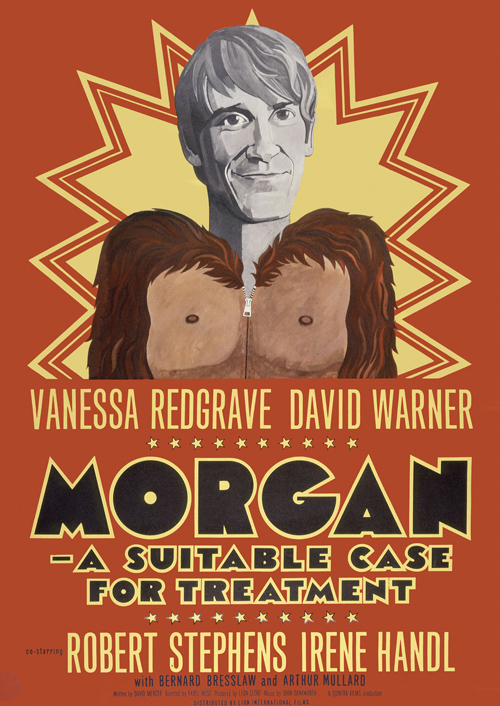
 "MORGAN—A SUITABLE CASE FOR TREATMENT" (1966, d. Karel Reisz)
"MORGAN—A SUITABLE CASE FOR TREATMENT" (1966, d. Karel Reisz)
One of the keystone works of British cinema right on the cusp of the Swinging 60's, this madcap comedy by Czech-born director Reisz, who first made his reputation as a critic for Sight and Sound and later in documentary films before scoring with the Angry Young Man-ish "Saturday Night and Sunday Morning", is both heartbreaking, and a triumphant blow for non-conformity in the face of an indifferent world. "Morgan" became a big student favorite around the world upon release, and was spoken of reverentially in the same breath as Philippe De Broca's "King of Hearts", another film positing madness as the only sane strategy to adopt in dealing with the slings and arrows of an outrageously uptight and conservative Establishment. Garnering a large cult following over many years, the film concerns the adventures of failed London-based painter and anti-hero Morgan Delt (David Warner), who was raised a Marxist Communist by his working class parents. David Warner's idiosyncratic, affecting and intense performance can be seen as kind of a gloss on Alec Guinness's Gulley Jimson character (the artist as scalawag) in Ronald Neame's hilarious 1958 film "The Horse's Mouth", but with some neurotic 60's twists added into the mix. This anarchic black and white film, whose frenetic energy is very much in the spirit of the times, utilizes quite a few of of Richard Lester's pop-art tricks from "A Hard Day's Night" (speeding up sequences for instance to give them a herky-jerky silent film look), but is not at all dated and still holds up quite well today….and it manages to plumb some real emotional depths in the portrayal of the semi-tragic relationship of Morgan and his upper-class wife Leonie (Vanessa Redgrave), who is divorcing Morgan to take up with a posh art dealer who is also of her class. I don't want to give away too much and spoil the film for you, but "Morgan" anticipates, and in many ways sets the stage for Mike Nichols's "The Graduate".
-
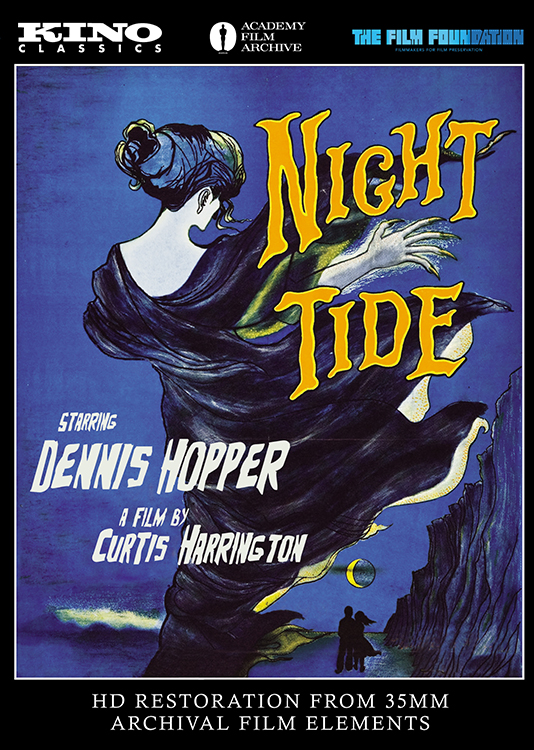
 "NIGHT TIDE" (1960, d. Curtis Harrington)
"NIGHT TIDE" (1960, d. Curtis Harrington)
An offbeat horror classic that cost a mere $75,000 to make, written and directed by the largely and unfairly overlooked filmmaker Curtis Harrington, whose impressive film and tv output spans experimental short films lionized at European film festivals in the 40's and 50's ("Fragment of Seeing", "The Wormwood Star"), to mainstream genre fare for major studios in the 60's ("Games" with Simone Signoret, "Who Slew Auntie Roo?"), to directing episodes of "Dallas" in the 70's. A native of Southern California, Harrington made a version of Poe's "Fall of the House of Usher" while still a teenager, and after getting his degree in film studies from USC wrote a monograph on director Joseph Von Sternberg. Basing himself in Hollywood, Harrington ran with the outsider art-crowd, his inner circle consisting of folks like Roger Corman, Dennis Hopper (who stars in this film), Forrest J. Ackerman (literary agent and editor of "Famous Monsters of Filmland"), and Kenneth Anger (author of hot gossip tell-all "Hollywood Babylon", and director of "Inauguration of the Pleasure Dome", which Harrington acted in). An openly gay director, Harrington is regarded as the Father of the New Queer Cinema, and his memoir "Nice Guys Don't Work in Hollywood" is thoroughly recommended. In this black and white cult classic, Dennis Hopper plays a lonely sailor on shore leave in Venice California who falls in love with a woman employed as a mermaid in a seedy carnival side show…a woman who may or may not be an actual mermaid, a descendant of the Sea People. Floyd Crosby who photographed much of Corman's Edgar Allan Poe cycle does the cinematography honors here, and producer Corman himself put the money up to get the picture out of the film lab about to foreclose on it due to unpaid bills, and into general release three whole years after completion. There are a couple of sequences in recent film "The Lighthouse" which directly lifts certain images from this film—perhaps it was an "homage"—but as most people have never seen "Night Tide", was it a mere nod and a wink to the arthouse crowd? In any case this particularly peculiar and downright weird film is not to be missed.
-
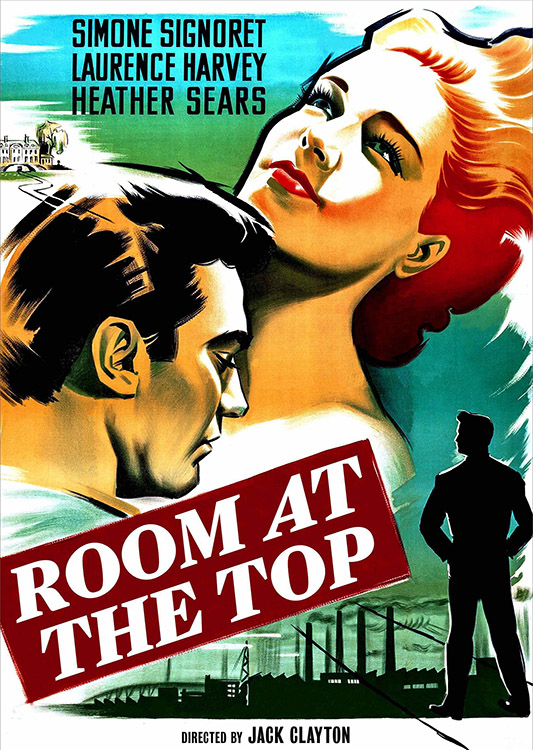
 "ROOM AT THE TOP" (1959, d. Jack Clayton)
"ROOM AT THE TOP" (1959, d. Jack Clayton)
One of the most poignant films to emerge from the Angry Young Man School of British post-war alienation, this gritty black and white melodrama was a commercial and critical hit marking the directorial debut of British film industry veteran Jack Clayton, a director's director highly regarded by folks like Martin Scorsese—and it spearheaded what became known as the British New Wave of kitchen-sink realism, with much frank talk about sex (shocking at the time). Clayton brings the celebrated novel by John Braine to life with stellar performances from a cast that includes moody Laurence Harvey in his breakout role as Joe Lampton, an ambitious, small-town social-climbing lad on the make. After moving from a dreary backwater town in West Yorkshire to a larger city, Joe takes a room in a boarding house considered a plum lodging (hence the films' title, which also refers to Joe's ambitious agenda), and snags a steady but underpaid job in the City Treasurer's Department. Against the advice of his friend and colleague Joe decides to pursue the daughter of a local industrial magnate in order to upgrade his social position. After a brief unconsummated flirtation, her fearsome father played by veteran British actor Donald Wolfit sends her abroad, and caddish Joe begins an affair with an unhappily married older French woman, soulfully played by Simone Signoret. It's all downhill from there…but not so downhill as to have spawned a sequel, the little known but fascinating "Life at the Top". "Room at the Top" launched Laurence Harvey's career, and was nominated for a slew of awards internationally, including 6 Academy Awards, with Signoret taking home the Best Actress Oscar.
-
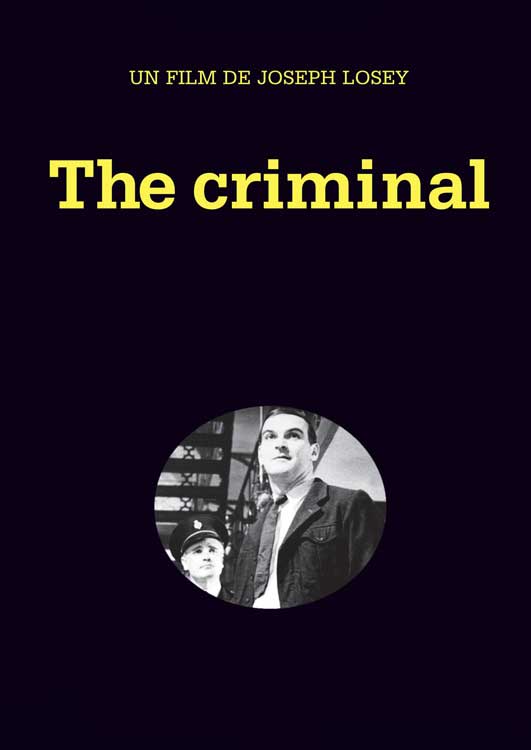
 "THE CRIMINAL" (1960, d. Joseph Losey)
"THE CRIMINAL" (1960, d. Joseph Losey)
Blacklisted American filmmaker Joseph Losey nails it again here with one of his best UK period films. This criminally underrated neo-noir gangster film, released in the US as "Concrete Jungle", stars one of Losey's favorite leading men, rugged "bit of rough" Stanley Baker, right up there with Sean Connery in the British Film Actors' manly-man pantheon (embodied today by the likes of Daniel Craig and Tom Hardy). Baker plays gangster Johnny Bannion, recently sprung from prison, who attempts to reconstitute that old gang of his with disastrous results. The scenes depicted inside prison are violently realistic and unsettling, and the film was banned in Ireland reportedly for portraying many of the prisoners as Irish Catholics. The film boasts an incredible cast of top English character actors as gang toffs, including Nigel Green (who was to pair again with Baker in the mid-60's blockbuster "Zulu"), Patrick Magee, Patrick Wymark, and Laurence Naismith, and on the distaff side, sexy Margit Saad and Jill Bennett as gang molls / lovers and castoffs of kingpin Baker. The imperious Baker was never more in his element than in a memorable welcome-home-from-prison party sequence, which degenerates quickly into a psychodrama and quasi-orgy, and in an unsuccessful race-track heist with uncanny echoes of Stanley Kubrick's superb gangster film "The Killing". The great Johnny Dankworth once again contributes a memorably jazzy score (the late Sir John's scores for Losey are always superb, and motivated me to seek his autograph on a DVD copy of Losey's film "The Servant" when Dankworth was last in NYC performing with his wife Dame Cleo Laine—a request which he graciously obliged).
-
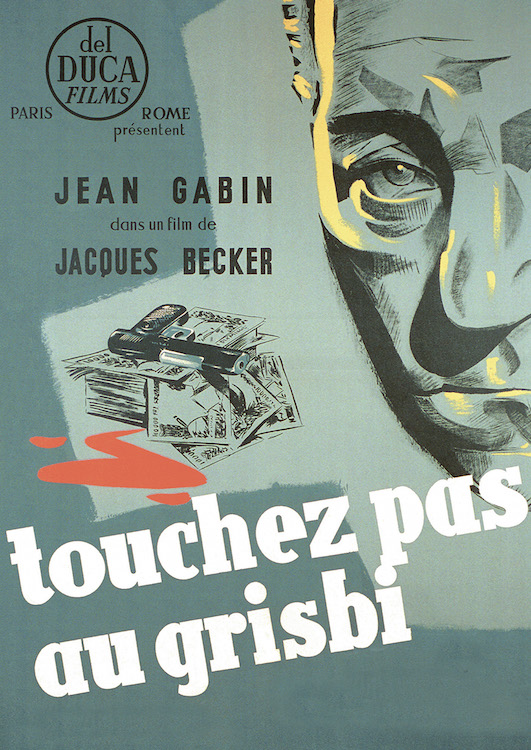
 "TOUCHEZ PAS AU GRISBI" (1954, d. Jacques Becker)
"TOUCHEZ PAS AU GRISBI" (1954, d. Jacques Becker)
Translated in English as "Don't Touch the Grisbi", "Grisbi" being French slang for "loot", this magnificent beast of a French-Italian crime film boasts a terrific cast headed up by French cinema lion Jean Gabin, who has never been so sympathetic playing a crime family boss with a heart of gold. A very decent and principled boss, albeit a crook, the film begins with Gabin having recently stolen 8 bars of gold with his gang, which he hopes to redeem for cash to finance his retirement, as he's sick of The Life. One night he goes to Pierrot's restaurant, his regular, with his best friend the gangster Riton played by Rene Vary, to see both of their burlesque dancer girlfriend perform, including Riton's gal Josy, played by a very young Jeanne Moreau, and Dora Doll as Gabin's dancer friend Lola. While at the club Gabin spies Josy making out with rival gangster Angelo played by Lino Ventura, and warns his friend, who's just been offered a job by Ventura. Gabin suspects that Josy informed Ventura of the existence of their gold (the "grisbi" of the title). As they leave the club they notice an ambulance driven by two of Angelo's men following them, and a chase ensues which explodes into a confrontation, with Gabin and Vary eventually driving their assailants off. Gabin insists Vary stay overnight at his apartment as it's not safe for him to be on his own that night , and a famous tenderly comic scene ensues of the the two old gangster pals dressing in silk pajamas furnished by a solicitous Gabin, who makes a bed on his couch for his friend, reminiscing warmly all the while of their lives together as two old partners in crime / bosom pals before the pair turn in for the night, Gabin to his bedroom and Vary to the couch. This early bromance scene was recently appropriated by Martin Scorsese in "The Irishman" between Al Pacino as Jimmy Hoffa and Jack Nicholson as his new bodyguard. I won't spoil the rest of the "Grisbi" fun here but suffice to say it's a classic, with plenty of betrayals, gun play, reversals of fortune, and wry comic observations on the endgame of a longtime crime boss. The film lifted the career of Gabin, which had been moribund after World War II, and is considered one of the absolute classics of French cinema.
-
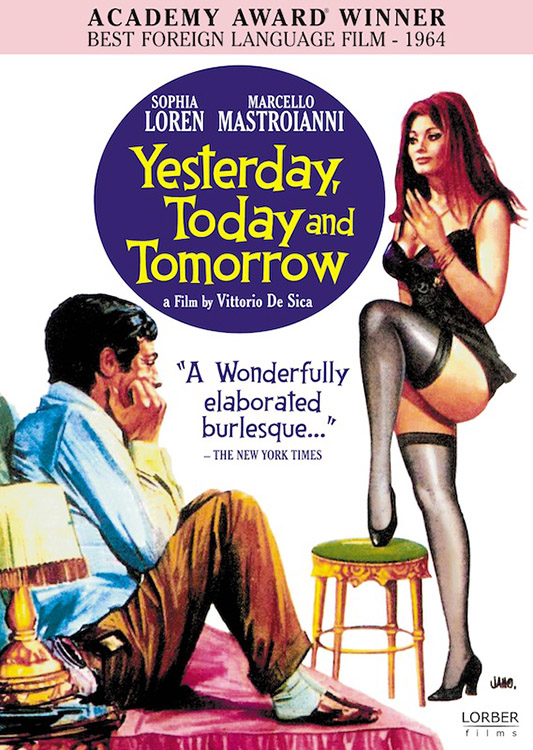
 "YESTERDAY, TODAY AND TOMORROW" (1963, d. Vittorio De Sica)
"YESTERDAY, TODAY AND TOMORROW" (1963, d. Vittorio De Sica)
A great way to end my pandemic list of excellent films available for streaming from Kino Now, this colorful comic anthology concerning the general use of sex by women as a weapon / negotiating tool is a real 60's treat that helped define contemporary Italian cinema of the day. It contains 3 delightfully ribald stories spanning the length and breadth of Italy, and stars iconic Italian film couple Sophia Loren and Marcello Mastroianni in all three episodes (one of them written by my favorite Italian novelist Alberto Moravia, who also wrote Godard's "Contempt"). "Yesterday, Today and Tomorrow" won Best Foreign Language Film Award at the 37th Academy Awards, and further cemented Loren and Mastroianni as an iconic screen couple on the order of Tracy and Hepburn in the public imagination worldwide. The first episode "Adelina of Naples" focuses on a poor Neapolitan couple whose female protagonist Sophia faces a fine and possible imprisonment for selling black market cigarettes right after the war to survive. She learns she can evade prison if she is pregnant, and then proceeds to have 7 children consecutively over 8 years fathered by the seriously exhausted and hapless Mastroianni. The second episode "Anna of Milan" concerns Loren as Anna, the bored, wealthy wife of a one-percenter Milanese industrialist, who is having an affair with her lover Renzo (Mastroianni) under her husband's nose. One day when the two lovers are out driving the husband's Rolls Royce, they narrowly miss running over a child and crash the Rolls—and a major turning point in their relationship follows. In the final episode "Mara of Rome" Sophia works as the prostitute Mara from her apartment, servicing many clients including the wealthy, powerful and neurotic son of a Milanese industrialist played by Marcello. Mara's neighbor's grandson, a callow young man studying to be a priest, becomes smitten with Mara, who tells him she does manicures for a living. He vows to quit the priesthood to be with her, or else join the French Foreign Legion. After many comic interludes the film ends with a sensational striptease by Sophia Loren, the sight of which could raise the dead. Good clean mildly suggestive fun for the entire family—and a great way to end my list.

